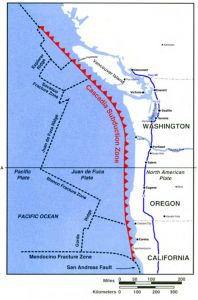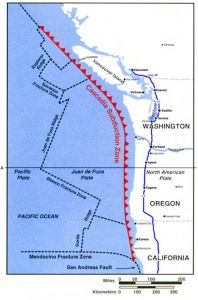The other week I included a sobering story from the New Yorker in Dispatches from the Future of Museums*. The Really Big One, by Kathryn Shulz, looks at the Cascadia fault line that runs for 700 miles down the coast of the Pacific Northwest, From Cape Mendocino California up to Vancouver.
At some point geologic slippage in this fault zone will result in an earthquake somewhere
between magnitude 8.0 and 9.2 on the Richter scale. For reference: the 2011 Tohoku earthquake and resulting Tsunami killed more than eighteen thousand people and triggered a meltdown at the Fukushima nuclear power plant. It did somewhere around two hundred and twenty billion in damage, including impact to least 353 cultural landmarks, and destroyed a number of museums.
In forecasting terminology, Earthquakes are “disruptive events,” in this case, events for which we know more or less what will happen, but can’t pinpoint when. As Shulz reports, scientists estimate the chance of a Cascadian earthquake in the vicinity of 8.0 in the next 50 years at roughly one in three, and of a “very big one” in the 9.2 range as one in ten.
Those are pretty bad odds, if you ask me, particularly for museums dedicated to preserving their collections for future generations.
What will the country (and museums) be dealing with when this quake occurs? Quoting Shulz,
“In the Pacific Northwest, the area of impact will cover some hundred and forty thousand square miles, including Seattle, Tacoma, Portland, Eugene, Salem (the capital city of Oregon), Olympia (the capital of Washington), and some seven million people. When the next full-margin rupture happens, that region will suffer the worst natural disaster in the history of North America. Roughly three thousand people died in San Francisco’s 1906 earthquake. Almost two thousand died in Hurricane Katrina. Almost three hundred died in Hurricane Sandy. FEMA projects that nearly thirteen thousand people will die in the Cascadia earthquake and tsunami. Another twenty-seven thousand will be injured, and the agency expects that it will need to provide shelter for a million displaced people, and food and water for another two and a half million.”
Or putting it more succinctly, the director of the FEMA division responsible for this region said “Our operating assumption is that everything west of Interstate 5 will be toast.”
In the face of these projections, what are we to do? As individuals, family members, community members—and museum professionals—what real choices do we make (other than ignoring the forecast)?
The barriers—psychological, cultural, logistic and economic—to doing anything are huge, but I would argue that to fulfill their public trust, museums in the Northwest have to prepare for “the very big one.” Hard choices might include:
· Identifying artifacts and specimens of such overwhelming importance that they ought to be reposited in other museums
· Jointly or individually creating inland storage facilities for collections of high value (monetary, historic, artistic, cultural or scientific)
· Relocating to the most stable location in their existing community, into buildings with state-of-the art earthquake resilience
We all face a range of risk every day—from bicycling to work to living in tornado corridor. But sometimes these risk rise to a level that demands a different kind of attention. In addition to raising awareness of the need for museums to grapple with extreme risk (whether in the Northwest Coast or elsewhere in the country or the world), I’m writing this post in the hope that you will tell me how you face these hard choices—personally or professionally. Please do share how you, or your museum, is grappling with the prospect of “the very big one.”
Elizabeth Merritt












Many collections holding museums in California and beyond think about this a lot – on the side of caring for our collections
A case study in living the unthinkable is Science Alive! science center in New Zealand. They lost their building in the terrible earthquakes in Christchurch in 2009, but have perservered as a community resource, helping residents cope with not just the science, but with the stress, uncertainty, and all of the fallout, literal and metaphorical, of the "unthinkable" that continues to impact their home
Thank you for pointing to the Christchurch example, Karen. That's a great example of responding to massively disruption. Do you know of any particularly forward-thinking ways California museums are preparing for a "great shake? Beyond retrofitting their buildings for earthquake resilience, that is.
Yesterday, Anchorage had a 6.3 quake and, across the ring of fire, Papua New Guinea suffered a 7.0, suggesting to me that the Pacific Plate is in a shift. I wouldn't be surprised if we had a very noticeable quake in the Pacific Northwest within the next two weeks.
If our only mission was to protect artifacts, we would be in the business of building bunkers, not museums. We are called to serve the communities around us, which invites all kinds of risk, big and small. We take the risk because we think what we do matters—that lives are changed and shaped by cultural experiences. I think it is a little ridiculous to suggest that museums in the risk zone start transferring important artifacts or pulling them from view so they can be kept inland. Is that what is best for the public? Should only “safe” parts of the world be allowed to enjoy certain kinds of artifacts? I’m not saying we shouldn’t be taking a hard look at our disaster plans, but the permanent removal of culturally valuable objects from the west coast is not the answer.
I think we are obligated to discuss this both with our internal museum audience and our external public audience. The discussion can help shape both the immediate emergency plan, but also the more important recovery plan that is often even less established. Where will the population go, how can the museum leverage this information both to evacuate objects, but also to assist their displaced community? Can the emergency plan be an opportunity to establish organizational partnerships across regions and topics? Although the event will be a tragedy, the planning and response can provide an opportunity to strength our organizations and communities. We need to use the opportunities as thought challenges to encourage action and fulfill the transition from the museums of today to the museums of the future.